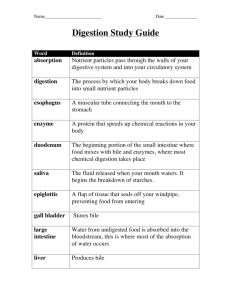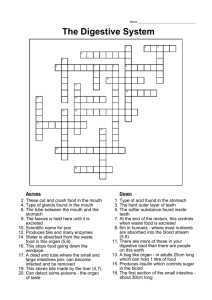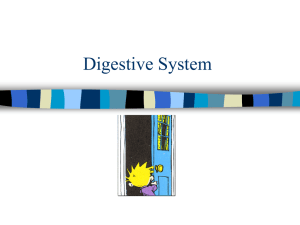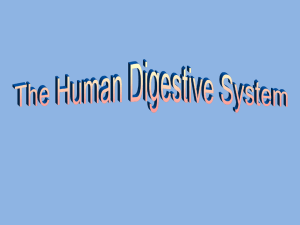Digestive notes - Powell County Schools
advertisement
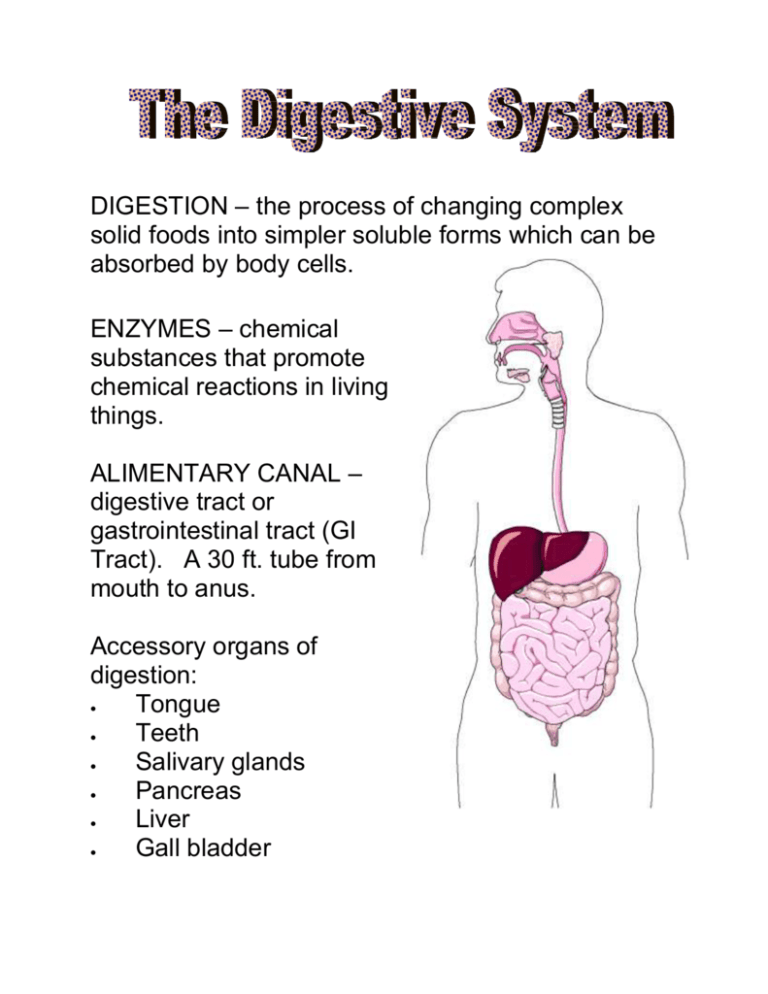
DIGESTION – the process of changing complex solid foods into simpler soluble forms which can be absorbed by body cells. ENZYMES – chemical substances that promote chemical reactions in living things. ALIMENTARY CANAL – digestive tract or gastrointestinal tract (GI Tract). A 30 ft. tube from mouth to anus. Accessory organs of digestion: Tongue Teeth Salivary glands Pancreas Liver Gall bladder Lining of the Digestive System PERITONEUM – double-layered serous membrane that lines the abdominal cavity Functions of the Digestive System 1. Physical breakdown of food 2. Chemical digestion of food into the end products of fat, carbohydrates and protein. 3. Absorb nutrients into blood capillaries of the small intestines 4. Eliminate waste products of digestion Structure of Organs of Digestion MOUTH Food enters digestive system through mouth Inside of mouth covered with mucous membrane Roof of mouth is HARD PALATE (bone) and soft palate UVULA – flap that hangs off soft palate – prevents food from going up the nose when you swallow TONGUE Attached to floor of mouth Helps in chewing and swallowing Made of skeletal muscle attached to four bones Taste buds on the surface SALIVARY GLANDS Three pairs of glands PAROTID – largest salivary glands, they become inflamed during mumps Secrete saliva TEETH GINGIVA – gums, support and protect teeth MASTICATION – chewing, teeth help in mechanical digestion DECIDUOUS teeth – baby teeth (#20) Adult mouth has 32 teeth ESOPHAGUS Muscular tube, 10” long Connects pharynx and stomach STOMACH Upper part of abdominal cavity CARDIAC SPHINCTER – circular layer of muscle, controls passage of food into stomach PYLORIC SPHINCTER – valve, regulates the entrance of food into duodenum RUGAE – mucous coat lining of stomach in folds when the stomach is empty Stomach has muscular coat that allows it to contract (peristalsis) and push food into the small intestine SMALL INTESTINE DUODENUM – first segment, curves around pancreas, 12” long JEJUNUM – next section, 8 ft. long ILEUM – final portion, 10-12 feet long ABSORPTION – in small intestine, digested food passes into bloodstream and on to body cells, undigestible passes on to large intestine Accessory Organs of Digestion PANCREAS Located behind stomach Exocrine function – secretes digestive enzymes Also has endocrine function LIVER Largest organ in the body Located below the diaphragm, upper right quadrant Connected to gallbladder and small intestine by ducts Functions: 1. Produce and store glucose in the form of GLYCOGEN 2. Detoxify alcohol, drugs and other harmful substances 3. Manufacture blood proteins 4. Manufactures bile 5. Store Vitamins A, D and B complex GALL BLADDER Small green organ, inferior surface of the liver Stores and concentrates bile until needed by the body When fatty foods digested, bile released by gallbladder LARGE INTESTINE CHYME – semi-liquid food Approx 2” in diameter Also called the colon CECUM – lower right portion of large intestine APPENDIX is finger-like projection off cecum RECTUM – last portion of large intestine ANUS – external opening Digestion BOLUS – soft, pliable ball – creating from chewing and addition of saliva – it slides down esophagus PERISTALSIS – wavelike motions, moves food along esophagus, stomach and intestines In the mouth… saliva softens food to make it easier to swallow PTYALIN in saliva converts starches into simple sugar under nervous control – just thinking of food can cause your mouth to water In the stomach… gastric (digestive) juices are released stomach walls churn and mix (This mixture is chyme) small amount of chyme enters duodenum at a time - controlled by pyloric sphincter takes 2-4 hours for stomach to empty In the small intestine… where digestion is completed and absorption occurs addition of enzymes from pancreas and bile from liver/gallbladder In the large intestine… regulation of H2O balance by absorbing large quantities back into bloodstream bacterial action on undigested food – decomposed products excreted through colon – bacteria form moderate amounts of B complex and Vitamin K gas formation – 1-3 pints/day, pass it through rectum (FLATULENCE) 14 times a day, bacteria produce the gas FECES – undigested semi-solid consisting of bacteria, waste products, mucous and cellulose DEFECATION – when lg intestine fills, defecation reflex triggered – colon and rectal muscles contract while internal sphincter relaxes – external anal sphincter under conscious control HEARTBURN Acid reflux Symp – burning sensation Rx – avoid chocolate and peppermint, coffee, citris, fried or fatty foods, tomato products – stop smoking – take antacids – don’t lay down 2-3 hours after eating GASTROENTERITIS Inflammation of mucous membrane lining of stomach and intestine Common cause = virus Symps – diarrhea and vomiting for 24-36 hours Complication = dehydration ULCER Sore or lesion that forms in the mucosal lining of the stomach Gastric ulcers in the stomach and duodenal ulcers in the duodenum Cause – H. pylori (bacteria) is primary cause Lifestyle factors that contribute: cigarette smoking, alcohol, stress, certain drugs Symp – burning pain in abdomen, between meals and early morning, may be relieved by eating or taking antacid Diagnosis – x-ray, presence of bacteria Rx – H2 blockers (drugs) that block release of histamine APPENDICITIS When appendix becomes inflamed If it ruptures, bacteria from appendix can spread to peritoneal cavity HEPATITIS A Infectious hepatitis Cause – virus Spread through contaminated food or H2O HEPATITIS B (Serum Hepatitis) Caused by virus found in blood Transmitted by blood transfusion or being stuck with contaminated needles (drug addicts) Health care workers at risk and should be vaccinated Use standard precautions for prevention CIRRHOSIS Chronic, progressive disease of liver Normal tissue replaced by fibrous connective tissue 75% caused by excessive alcohol consumption CHOLECYSTITIS Inflammation of gallbladder CHOLELITHIASIS Gallstones Can block the bile duct causing pain and digestive disorders Small ones may pass on their own, large ones surgically removed Surgical removal of gallbladder = CHOLECYSTECTOMY DIARRHEA Loose, watery, frequent bowel movements when feces pass along colon too rapidly Caused by infection, poor diet, nervousness, toxic substances or irritants in food CONSTIPATION When defecation delayed, feces become dry and hard Rx – diet with cereals, fruits, vegetables, (roughage), drinking plenty of fluids, exercise, and avoiding tension JAUNDICE Yellow color of the skin



